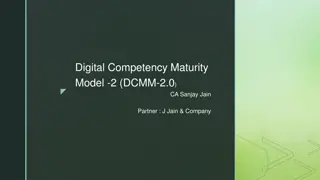Digital Communications Techniques in CTE Department - 3rd Stage
Explore Differential Pulse Code Modulation (DPCM) and Delta Modulation (DM) concepts in digital communications, as outlined in the 2018-2019 curriculum of the CTE Department. Learn about encoding, quantization, error prediction, reconstruction at the receiver end, and the one-bit per sample transmission method employed in DM. Gain insights into how these techniques reduce redundancy, decrease bit rates, and optimize signal transmission efficiency.
Download Presentation

Please find below an Image/Link to download the presentation.
The content on the website is provided AS IS for your information and personal use only. It may not be sold, licensed, or shared on other websites without obtaining consent from the author. Download presentation by click this link. If you encounter any issues during the download, it is possible that the publisher has removed the file from their server.
E N D
Presentation Transcript
. : 2018-2019 Digital Communications CTE Department -3rdstage Reference: Digital Communications Fundamentalsand Applications, 2nd Addition, byFernardSklar Dr. Hussam Dheaa Kamel Al-Mustafa University Collage CTE Department 2018-2019
CTE Department -3rdstage Digital Communications 2-7 Differential Pulse Code Modulation (DPCM): Any signal does not change fast, so that the value from present sample to next sample does not differ by large amount. The adjacent samples of the signal carry the same information with little difference as shown if figure 2-11. Figure 2-6 Redundant information of PCM It can be seen from figure 2-11 the samples 4??, 5??, ??? 6??are encoded to the same value of (110). If this redundancy is reduced, the overall bit rate will decrease and the number of bits required for one sample will also be reduced. This is called Differential Pulse Code Modulation (DPCM). DPCM works on the principle of prediction. The value of the present sample is predicted from the past samples as shown in figure 2-7. 2
CTE Department -3rdstage Digital Communications Figure 2-7 DPCM transmitter The comparator fined the difference between the actual sample value ?(???) and predicted signal ? (???) this is called error ?(???): ?(???) = ?(???) ? (???) This error will be quantized and encoded by small number of bits. Thus number of bits per sample are reduced in DPCM. The quantization error can be written as: ??(???) = ?(???) + ?(???) The prediction filter input is: ??(???) = ? (???) + ??(???) 3
CTE Department -3rdstage Digital Communications Substituting by ??(???) yields ??(???)=? (???) + ?(???) + ?(???) We have ?(???) = ?(???) + ? (???) From the last equations; ??(???)=?(???) + ?(???) To reconstruct the original signal at the receiver, the decoder first reconstructs the quantized error signal as shown in figure 2-8. Figure 2-8 Reconstruction of DPCM The quantized error signals are summed up with prediction filter output to give the quantized version of the original signal. The signal at the receiver differs from actual signal by quantization error ?(???). 4
CTE Department -3rdstage Digital Communications 2.8 Delta Modulation (DM): DM transmit only one bit per sample. That is the present sample value is compared with the previous sample of approximated signal which confined to two levels ( ? ??? + ?). If the difference is negative 0 bit is transmitted and 1 bit is transmitted for positive difference, as shown in 2-9. Figure 2.9 Delta modulation waveform 5
CTE Department -3rdstage Digital Communications - DM transmitter: The block diagram of DM transmitter is shown in figure 2-10 Figure 2.10 DM transmitter The error between sampled value of ?(?) and last approximated sample is given by: ?(???) = ?(???) ? (???) From the waveform figure ?(???) is the present sample approximation of staircase output and ?[(? 1)??] = ? (???) is the last sample approximation of staircase output. Let the quantity of ?(???) be define as, ?(???) = ?????[?(???)] So that ?????? 1 ?? ??????????? ?(???) = +? ?? ?(???) ? (???), ?????? 0 ?? ??????????? ?(???) = +? ?? ?(???) < ? (???), 6
CTE Department -3rdstage Digital Communications Where ??is sampling interval. The summer of figure 2-7adds quantizer output ( ?) with previous sample approximation. This gives present sample approximation: ?(???) = ?(??? ??) + [ ?] ?? = ?[(? 1)??] + ?(???) The previous sample approximation ?[(? 1)??] is restored by delayed one sample period ??. The sampled input signal ?(???) and staircase approximated signal ? (???) are subtracted to get error signal ?(???). Then the one bit quantizer produces +? or ? step size depending on the sign of ?(???), 1 bit is transmitted for positive values and 0 bit for negative values. 7
CTE Department -3rdstage Digital Communications - DM receiver: At the receiver shown in figure 2-11, the accumulator generates the staircase approximated signal and is delayed by one sample period ??. It adds +? step to the previous sample if the input bit is 1 and subtract ? for 0 input bit. The low pass filter with cutoff frequency of highest frequency in ?(?). Figure 2.11 DM receiver - Advantageous ofDM: DM transmit only one bit for one sample. Thus the signaling rate and transmission channel bandwidth is quite i- small for DM. ii- The DM transceiver system is very much simple. 8
CTE Department -3rdstage Digital Communications - Disadvantageous ofDM: Figure 12 distortion of DM Slop overload distortion: This distortion arises because of large dynamic range of input signal. In this case the step size ? is too small for staircase signal ?(?) to follow the steep segment of ?(?). Thus there is large error between i- those signals. This error called slop overload distortion. To reduce this error the step size should be increased when slop of signal ?(?) is high. But since the step size is fixed it is called Linear Delta Modulation (LDM). ii- Granular Noise (Hunting): It is occur when the step size is too large compared to small variation in the input signal ?(?) which can be considered flat, while the staircase signal is oscillated by ? around it. The error in this case is called granular noise, so that step size should be small to reduce this error. 9
CTE Department -3rdstage Digital Communications 3.9 Adaptive DM: The large step size is required to reduce slope overload while small steps are required to reduce granular noise. Adaptive DM shown in figure 2-9 is a modification of LDM to overcome these errors. Figure 2.13 Transmitter of adaptive DM The step size increases with steep segment of input signal and reduces with small variation. This called Adaptive Delta Modulation (ADM). At the receiver the logic for step size control is added is added as shown in figure 2-9. 10
CTE Department -3rdstage Digital Communications Figure 2.14 ADM receiver If one bit quantizer output is high 1 the step size may be doubled for next sample and vice versa as shown in figure 2-10. Figure 2.15 Waveform ofADM The previous input and the present input decided the step size. 11























